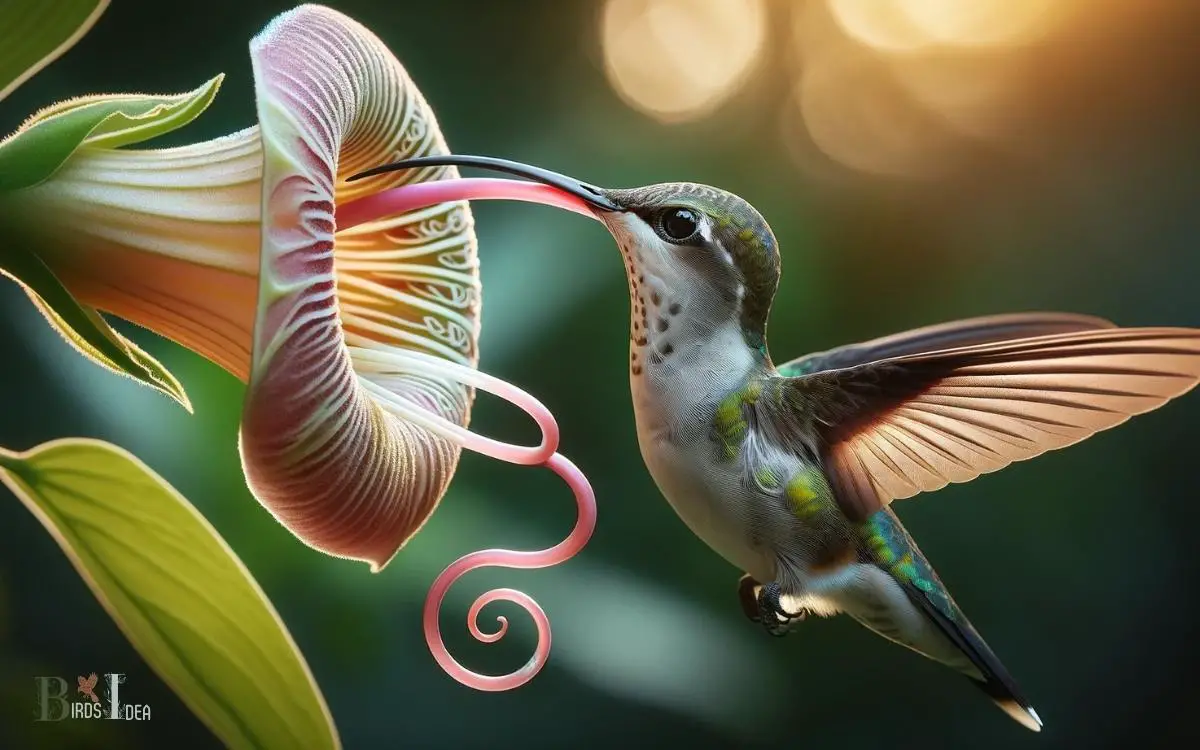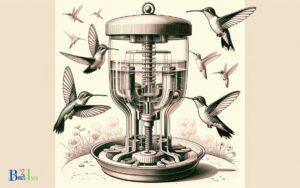What Is an Adaptation That Helps Hummingbirds Obtain Food?
The hummingbird’s beak is a specialized adaptation that facilitates efficient nectar extraction and insect capture, enabling these birds to access their primary food sources.
Hummingbirds have evolved long, slender beaks that allow them to reach deep into flowers to access nectar, which is a vital energy source for them.
Additionally, their beaks can be used to skillfully pluck insects and spiders out of the air or from spider webs, providing essential proteins.
Discover how the hummingbird’s beak is perfectly shaped to meet its dietary needs, ensuring survival through specialized feeding tactics.

Key Takeaway
Evolution of Hummingbird Beak
The evolution of the hummingbird beak has been a crucial adaptation in enabling these birds to obtain food.
Over time, the beak of the hummingbird has evolved to be long, slender, and tapered to a fine point, allowing them to reach deep into flowers to access nectar.
This specialized beak shape also facilitates their ability to catch small insects and spiders, providing a vital source of protein in their diet.
The evolution of the hummingbird beak showcases nature’s incredible ability to adapt to specific ecological niches, ensuring these birds can thrive in their unique feeding habits.
Understanding the evolutionary process of the hummingbird beak provides valuable insights into the intricate relationship between form and function in the natural world.
This evolution has paved the way for the astonishing feeding mechanisms found in hummingbirds, which we will explore further in the subsequent section about the anatomy of the hummingbird beak.
Anatomy of Hummingbird Beak
Evolution of the hummingbird beak has resulted in a specialized anatomy suited for extracting nectar from flowers and capturing small insects and spiders.
The beak is long, slender, and tapers to a fine point, allowing for precision in feeding. It is specially adapted to fit deep within the corolla of tubular flowers, reaching the nectar hidden within.
The upper and lower mandibles are both highly flexible, enabling the hummingbird to open its beak wide to capture insects in flight.
Additionally, the beak is equipped with fine, hair-like extensions called lamellae, which aid in the capture of small insects and spiders.
This intricate anatomy allows hummingbirds to efficiently obtain the diverse range of food sources necessary to sustain their high metabolism, ultimately contributing to their vital role in pollination and ecological balance.
Nectar Extraction Mechanism
The nectar extraction mechanism in hummingbirds is facilitated by the unique shape of their beaks and the specialized structure of their tongues.
The slender, elongated beak allows hummingbirds to reach deep into flowers to access nectar, while their specialized tongue is capable of rapidly lapping up the sweet liquid.
These adaptations enable hummingbirds to efficiently extract nectar from flowers, supporting their high energy needs for sustained flight and metabolism.
Hummingbird Beak Shape
Hummingbird beak morphology plays a crucial role in their nectar extraction mechanism. Their specialized beak shapes are designed to efficiently obtain nectar from flowers, allowing them to serve as pollinators and obtain the sustenance they need.
The following are key adaptations of hummingbird beak shapes:
- Long and slender beaks: These beaks are ideal for reaching deep into tubular flowers to access nectar.
- Curved and narrow beaks: This shape allows hummingbirds to reach the nectar at the base of long, tubular flowers.
- Short and sturdy beaks: These beaks are adapted for accessing nectar from shorter, more open flowers.
Understanding the diverse beak shapes of hummingbirds is crucial for those serving them, as it enables the provision of appropriate feeders and flowers to support their unique feeding behaviors.
This knowledge also sets the stage for delving into the subsequent section about ‘specialized tongue structure’.
Specialized Tongue Structure
Adapting to different flower shapes, hummingbirds utilize a specialized tongue structure to extract nectar from deep within flowers.
Their tongues have evolved to be long, extendable, and highly flexible, allowing them to reach the nectar hidden in the elongated corollas of certain flowers.
The tongue’s unique structure enables hummingbirds to lap up nectar at a rapid rate, making them remarkably efficient at obtaining the energy-rich substance.
With tiny, hair-like projections on the tip of their tongues, they can also collect the nectar through capillary action, ensuring no drop goes to waste.
This adaptation is crucial for the survival of hummingbirds as it facilitates their ability to access food from a wide variety of floral shapes, thus enabling them to serve their nutritional needs while also pollinating the flowers they feed from.
Insect Catching Abilities
With remarkable agility and precision, hummingbirds capture insects while in flight to supplement their nectar-based diet.
Their insect-catching abilities are facilitated by:
- Exceptional aerial maneuverability: Hummingbirds can swiftly change direction and hover in mid-air, allowing them to pursue and intercept flying insects with ease.
- Specialized beak shape: The elongated and slender beak of hummingbirds enables them to snatch small insects from the air with great accuracy.
- Lightning-fast reaction time: Hummingbirds possess incredibly quick reflexes, allowing them to react to the rapid movements of insects and swiftly capture their prey.
These remarkable adaptations showcase the hummingbird’s efficiency in obtaining essential proteins and nutrients from insects, contributing to their overall diet and well-being.
Role of Beak in Food Acquisition
The specialized beak of hummingbirds plays a crucial role in the acquisition of food, enabling them to snatch small insects from the air with great accuracy and efficiency.
Hummingbirds have long, slender bills that are perfectly adapted for reaching deep into flowers to feed on nectar.
The upper and lower parts of the beak are specially shaped to fit together, forming a tube-like structure that allows them to draw nectar out of flowers. Additionally, the tip of the beak is often slightly curved, aiding in the capture of insects.
This specialized tool allows hummingbirds to access food sources that might be out of reach for other birds, showcasing the remarkable adaptation of their beak for efficient food acquisition.
Understanding the unique role of their beak can help us appreciate the incredible abilities of these tiny birds and how they serve the ecosystem through pollination and insect control.
Adaptation for Efficient Feeding
The long, slender bills of hummingbirds enable them to efficiently draw nectar from flowers and capture small insects with remarkable precision.
This adaptation for efficient feeding allows hummingbirds to thrive and fulfill their crucial role in pollination.
The following features demonstrate how hummingbirds’ beak adaptation aids in efficient feeding:
- Specialized Tongue: Hummingbirds have long, extendable tongues with fringed tips that allow them to lap up nectar from deep within flowers, maximizing their food intake.
- Rapid Metabolism: Their high metabolic rate necessitates frequent feeding, and their specialized beaks enable them to swiftly access energy-rich nectar to sustain their active lifestyle.
- Precise Insect Capture: The slender, curved bills of hummingbirds enable them to snatch small insects from the air or flowers, contributing to their protein intake for a well-rounded diet.
Understanding the efficacy of hummingbirds’ beak adaptation is pivotal in comprehending their survival strategies and ecological impact.
Why is Having a Hummingbird Feeder an Effective Adaptation for Attracting Hummingbirds?
Having a hummingbird feeder is an effective adaptation for attracting hummingbirds to feeders. These feeders are specifically designed to cater to the feeding needs of hummingbirds, with nectar-like liquids that mimic their natural food sources. This approach ensures that the birds are enticed to visit your feeder, increasing the chances of attracting hummingbirds to the feeder and enjoying their graceful presence.
Impact of Beak Adaptation on Survival
Hummingbirds’ beak adaptation significantly enhances their survival by facilitating efficient food acquisition and enabling them to meet their high metabolic demands.
The specialized structure of their beaks allows them to access nectar from deep within flowers, giving them an advantage in competing for food resources.
This adaptation also enables them to feed on small insects and spiders, diversifying their diet and ensuring they have a nutrient-rich intake.
The ability to obtain food more efficiently means hummingbirds can spend less time foraging and more time resting, conserving energy for other essential activities such as migration and reproduction.
Additionally, their unique beak shape and length are crucial for reaching into specialized flowers, making them effective pollinators and contributing to the overall health of ecosystems.
| Beak Adaptation Benefits | |
|---|---|
| Efficient food acquisition | |
| Diverse diet | |
| Energy conservation | |
| Effective pollination | |
| Ecosystem health |
Conclusion
The adaptation of the hummingbird beak has played a crucial role in the bird’s ability to obtain food.
The evolution of its beak, nectar extraction mechanism, and insect-catching abilities have all contributed to the efficient feeding of hummingbirds.
This adaptation has had a significant impact on the survival of the species, allowing them to thrive in their environment and evoke a sense of wonder and admiration for their remarkable abilities.






